Waste of Resources
Index:
Waste of Resources:
- Material efficiency and waste
- Waste management in use
- Waste Hierarchies
- Other waste hierarchies
- Construction Demolition & Excavation Waste: Facts & Figures
About:
MATERIALS EFFICIENCY AND WASTE
- Design to reuse second hand reclaimed materials: find the materials then design the building around them
- E.g. Steel in Doncaster’s Earth Centre Roofs, by Bill Dunster
- The total CO2 created by making materials for a building can be reduced by reuse and recycling materials
- Avoid materials that downcycle as opposed to recycle: e.g. PVC’s properties change in reprocessing so Virgin PVC must be used or recycled PVC has limited application
- Steel normally contains a high percentage of scrap added in smelting process and can be reprocessed into same grade of steel
- Design to minimise waste: acknowledge the manufacturing size when designing components and assemblies
- Acknowledge brick sizes when designing wall lengths, same applies to blockwork and timber constructions
- Ensure the design of a building accommodates easy storage of separate recyclate, easy composting routes (e.g. direct exit from kitchen worktop to external composting system for organic green waste)
- Design for low cost, efficient deconstruction
CONSIDER
- Compatibility of material mix, to increase quality of ‘deconstructed’ materials for re-use or recycling purposes
- Avoid polymer migration between plastics
- Minimise use of composites that are difficult to separate, this applied to packaging too
Deconstruct not demolition:
- Assemble steel framed building with clamps and bolts in preference to welding; this permits a degree of off-site prefabrication and simple on-site work
- Assemble timber buildings with bolts, screws and other fasteners in preference to nailing and adhesives
- Assemble with locational methods of assembly, e.g. Insulation squeeze insert release
- Assemble using ballast in preference to fastenings and adhesives to allow the building to be deconstructed, and components to be used again. E.g. waterproof membranes
- Design for deconstruction and reuse: avoid welding, adhesives and nails; use, clamping, bolting, ballast and screws
- Enable product-purchase to become function-purchase – e.g. very low cost leasing of mechanical or electrical systems and heating appliances; maintains optimum efficiencies and therefore lower carbon emissions through appropriate servicing, and reduces capital costs, enabling operational savings to pay for higher cost of environmentally-better equipment
WASTE MANAGEMENT IN USE:
- See R31 for more detail
- Waste segregation at the kitchen sink
- EcoHomes: Minimum 3 bins: under kitchen sink and 3 bins outside
- Compostable, Recyclable & Waste
- Waste segregation bins and temporary storage
- Composting for soil improvement
- Vertical home grown food
- Offsite segregation is possible with the right partnering, at segregation and bulking sites
WASTE HIERARCHIES:
- Waste Hierarchies: Establishment definition (Pre-2011)
- Reduce, Reuse, Recycle, Recover
Waste Hierarchy
- If rejected, find a ways to reuse it
- if rejected, find a way to recycle it
- Incinerate to recover energy
- Landfill
Waste Hierarchy
NGS definition/the ideal
- Refuse, Reject, Return, Redesign, Reduce, ReSpec, Reuse, Reclaim, Retain, Recycle, Recover
Refuse
- Refuse unnecessary, excessive, complex or all packaging and protection
- Under the Packaging Producer Responsibility Act the manufacturer is responsible for dealing with waste packaging
- either directly or by others at their expense
- Segregate it and require it to be collected by the producer after installation/practical completion
Refuse
- Supply chain management:
- Partnering can offer opportunities to demand a better service from manufacturers
- Reduction in packaging
- Reconsideration of pallet packing
- Adequate protection and no more
- Return of all packaging to source
Reject
- Ensure all deliveries are checked
- Reject defective material
- Return rejects to supplier/manufacturer for them to be replaced with merchantable quality
- Defective materials should be returned to supplier/manufacturer, they may salvage materials and reuse them
- Let them foot the waste removal bill and not the site
Return
- Sale or return ensures over ordered and unused materials can be taken back into stock if unused
- Take-back schemes provide waste containers or skips for collection of scraps and return to manufacture to reuse as raw materials
- Schemes are emerging to return materials to manufacturer, at low cost
- Courier companies in a hurry delivering packages return empty, offering slow returns of goods to source
- Damaged or waste materials can be returned to manufacturer with multiple deliveries
- Packaging Producer Responsibility Regulations make it possible to send packaging back to manufacturers
- Better still for them to collect it
Redesign to reduce
- Reduce off-cuts by designing to manufactured sizes
- Walter Segal’s Segal Method used 8×4 sheets and 4×2 and 8×2 timbers
- No waste, only cutting to length and drilling
Reduce Demand
- Don’t over design structure
- Except if long design life demands it
- Don’t oversize
- Don’t cut L from rectangle use two rectangles to make it
- Reduce quantity of materials, energy, etc. used and wasted
Respecify to Reduce Rejects
- CONSIDER lowering standards to reduce rejection rate
- natural materials have natural variations: select logs don’t reject final products
- Quality rejects or offcuts from “for sale” might go into “for rent”
- damaged face used in hidden face
Reuse
- No changes occur to the materials reused in exactly the same form
- Bricks reused as bricks (lime mortar removed)
- Lime is reusable
- Doors reused as doors (some repairs required)
CONSIDER
- materials for reuse in new works, e.g
- Off cuts reused as blocking and props in timber framing
Reclaim
- Salvage and reuse of demolition and construction materials
- Methods of assessment or test of materials
- Softwood timbers for use in timber studwork
- Salvage inspection chamber covers and frames
- Recycled materials
- Downcycled materials
- Upcycled materials
Retain
- Retain unused materials for Reuse/Repair
- Snagging at end of job
- Defects Liability Period Repairs
- Employers FM in maintenance/repair
- Sheets of flooring from same batch
- Pots of paint from same batch
- Spares for components
Recycle
- Properties of material do not change can be recycled as same materials
- Metals recycled as Metals
- (fine chemical corrections are part of normal production)
- Can the project make use of any existing redundant materials?
- Can the Employer (Client) make use of the materials on site/campus?
- Grub up brickwork inspection chamber and ground floor and foundations and reduce for hardcore
Downcycle
- Reduction in properties often occurs in plastics
- Can’t be used in original form
- Relegated to a lesser or different task
- Polyethylene sheet as black bin bags
Upcycle
- Where a material can be converted into something better (greater value) in its second life:
- Scaffold board used in making a door
- Pallets dismantled and made into furniture
- Subsoil and green waste compost mixed to make topsoil
- Landscape waste: Grass, leaves, new growth trimmings, shrubs: can any be composted?
Recover
- Rubber tyres are being reduced to:
- recycled metal wires
- reinforcing of concrete and screeds
- rubber crumb
- soft paving materials
- acoustic isolation strips
Recovered Materials
- WRAP EnviroCentre Halcrow defn:
- Recycled demolition materials
- Recovered Secondary Aggregates
Waste Hierarchy: The reality
- Reduce: very little is done, its nobody’s responsibility
- Reuse & Recycle: some but not enough
- Incinerate: too much
- Landfill: very high percentage
Incinerate
- Rubber tyres are being reduced to a high calorific value fuel in Cement Kilns to reduce CO2 emissions
- Some domestic waste is incinerated to generate electricity
Landfill
- Where only the last few bits are left that cannot be put to other use
- In reality most goes there by default
OTHER WASTE HIERARCHIES
- New-build
- Landscape
- Existing Buildings
- Brownfield Sites
- Remediate Fill sites
- Demolition
- Run down areas
New-build:
- Redesign to Reduce
- Redesign to Deconstruct
- Re-specify to Reduce Rejection
- Recheck quantities Required
- Reduce defects by protection
- Return excess to source
- Reuse/Recover
New-build:
- Store for Remedial action: snagging
- Store for Repairs: 6 months defects
- Segregate to Reuse
- Segregate to Recycle
- Segregate to Reduce: Skip hire and Landfill Tax
- Remove foreign objects to recycle
Landscape
- Set-up composting areas on site
- Collect seeds and dry
- Rake grass and compost leaves
- Cut grass, Retain grass cuttings and compost
- Reclaim wild turf and flowers
- Post notice on exchange website to sell wild turf
- Retain topsoil in stockpiles
- Relay turf on topsoil stockpiles
- Retain subsoil in stockpiles
- Set seeds and turf on topsoil stockpiles to discourage weeds
Soft Landscape
- Spread subsoil over whole site to lose it
- Cut turf from topsoil stockpile
- Relay topsoil over subsoil
- Rejuvenate topsoil with Compost
- Relay turf on topsoil
- Recreate topsoil with subsoil & compost
- Relay any seeds
Hard Landscape
- Retain hard materials for hardcore
- Retain concrete to crush for aggregate
- Reuse aggregate in concrete mix to foundations and haunches
- Reuse hard materials as hardcore base to new paths and roads
Exiting buildings:
- Remove Remains of bird and animals
- Remove Recreational drug paraphernalia carefully
- Record details to Repeat
- Remove infected structure and fabric to incinerate off site
Exiting buildings:
- Reclaim for Reuse
- Recover for Repair and Refix
- Refurbish not Replace
- Redecorate
- Reoccupy
Brownfield site:
- Record Wildlife Biodiversity to be maintained or enhanced
- Reuse or recycle building and site
- Reuse site to regenerate area
- Recreate wild life habitat on Roof
Remediate fill sites:
- Resist Removing polluted fill to landfill
- Resist Removing fill to landfill
- Retain fill on site
- Cover and Vent
- Reduce ODP collect/burn methane
- Remediate soil insitu
- Raise to vent Radon Radioactive gas
- Raise floor level to avoid excavation of fill
Demolition:
- Record pre-demolition audit and post on Websites
- Recover FFE by soft strip, Reuse elsewhere
- Remove finishes which become impurities preventing reuse
- Deconstruct to Reclaim for Reuse
Demolition:
- Raze to the ground
- Reclaim for Reuse
- Reduce and Recycle
- Recycle, downcycle and upcycle
- Reuse the Reclaimed
A run down area:
- Renewal
- Regenerate
- Regentrify but not at the expense of the existing communities
CD&E CONSTRUCTION, DEMOLITION & EXCAVATION WASTE FACTS AND FIGURES
90 m tonnes of construction, demolition & excavation waste leaves site in a skip each year
Sources
EA survey (national survey, estimates, carried out in 1999/2000
- 72.5 m tonnes/annum
- Figures do not include road planings, nor materials re-used without processing on the site where they arose.
Mass Balance Survey Viridis/CIRIA Viridis report VR4 2002
- 90 m tonnes/annum
- More thorough survey, bigger range
BRE facts & figures Waste
- Total industries: 400 m tonnes/year
- Mining & Quarrying: 110 m tonnes/yr
- Construction Ind C,D&E: 90 m t/year
Resource Efficiency
(CIRIA/VIRIDIS REPORT VR4 2002)
- Can’t afford Green?
- QS cost plan does not allow for green materials
- So how do you get them into the project once in contract?
- Save on waste and afford all you want
- Save 50% of 36% you have 18% more budget to spend on materials
The hidden budget
- 36% wasted materials x 50% reduction in waste =
- 18% to spend on materials, labour is already allowed for
Cost of Waste
- DTI and CE Site Waste Management Plans event: 2004
- Waste accounts for 3% of build costs and 20% of materials costs
Savings from waste management
- Greenwich Millennium Village 1300 unit housing site £150,000 saved so far
- Swindon St Margaret’s Hospital £140m budget £850,000 saved by waste management alone
Waste management/minimisation
- Don’t over order and waste it (13m tonnes/annum)
- Reduce waste and save its value
- Redesign to reduce off-cuts (33% = 30 m tonnes/annum)
Waste Arising: Of the materials delivered to the UK’s building sites,
- 90 m tonnes/year leave in mixed material skips
- 17 – 21 m tonnes/year of packaging and protection
- 13 m tonnes/year is new and unused construction material
Waste Arising
- 13 m tonnes/year is new and unused construction material
- Not JIT Just in time but JIC Just in case
- Over ordered, never needed?
- Inaccurate measurement? +/-10%
- Late instructions, revised design?
- 50%-50% split of QRE Quality Related Events
Waste arising
- 33.8 m tonnes (46%) C,D&E waste mainly hard demolition waste:
- concrete and bricks, likely to include non-inert material such as timber and plasterboard
- 23.7 m tonnes (33%) soil including stones and rock and classed as ‘inert’
- 15.0 m tonnes (21%) mixed C,D&E waste and soil likely to include non-inert waste
BRE facts & figures: Construction waste by volume
- Timber 13.8%
- Concrete 10.2%
- Inert materials 7.1%
- Ceramics 8.6%
- Insulation 7.5%
- Plastics 3.2%
- Packaging 25.9%
- Metals 4%
- Plaster & Cement 11.5%
- Misc 9.6%
Key Waste Products KWP:
- Plastic Packaging
- Cardboard
- Timber Pallets
- Insulation
- Plasterboard
- Timber Generally
- Timber packaging
- Blocks
- Bricks
- Miscellaneous
Waste by Building type: Timber
- Office 1.195-2.58
- Office 0.201
- Leisure 0.058
- Restaurant 2.667
- Housing:
- Concrete 1.703
- Traditional 1.65-2.56
- Timber 1.244
- Hemp: 0.945
Common Waste Causes
- Offcuts: 33.2%
- Recyclable packaging: 18.7%
- Excess deliveries 18%
- Temporary materials: 10.3%
- Reusable packaging: 14.4%
- Site Office and Canteen: 4.1%
- Damaged through methods of work: 3.2%
- Unsuitable storage: 1%
- No apparent reason
- Excavation material
- Clearing site
Costs: sample project (BRE)
- Timber pkg £28k
- Plasterboard £26k
- Rockwool £16k
- Timber £16k
- Pallets £8k
- Blocks £1k
- Miscellaneous £6k
- Plastic pkg £2.5k
- Cardboard £2.5k
- Bricks £0.8k
Demolition waste % by volume (BRE limited studies)
- Concrete: 52.6%
- Ceramics: 22.5%
- Furniture 16.6%
- Timber 3.4%
- Miscellaneous 1.9%
- Metal 1.4%
- Plastic 1.3%
- Electrical Goods 0.3%
Demolition reuse and recycling potential (BRE limited studies)
- Reusable 40.6%
- Reusable but soiled 1.2%
- Recyclable 27.3%
- Energy from waste 3.4%
- Inert waste to landfill 17% 16mt
- Mixed waste to landfill 10.4% 9mt
Disposal routes
- Recycled aggregates and stone: 25 m tonnes
- Beneficially re-used at licensed landfills: 9.5 m tonnes
- Used at registered exempt sites: 20.3 m tonnes
- Disposed of at licensed landfills: 17.5 m tonnes
Recycling facts & figures
- Construction waste recycled 20%
- C,D&E waste recycled 45% (Hardcore)
- Reclaimed and reused in construction 3.3 m tonnes/year
- BRE figures based on EA survey 1999/2000
UK Reclamation Industry
- 1500 fragmented businesses
- Individually quite small
- Reuse of products rather than recycle saving processing energy
- 3m tonnes per year
- Main Markets are domestic
- Salvo’s Website is a hub to 150 companies
UK Reclamation Industry
- Stone walling 1083 k tonnes
- Clay/Stone paving 672 k tonnes
- Clay bricks 443 k tonnes
- Timber 371 k tonnes
- Clay roof tiles 306 k tonnes
- Timber beams 133 k tonnes
- Floor boards 101 k tonnes
- Antique stone 90 k tonnes
- Iron & Steel 90 k tonnes
- Antique timber 29 k tonnes
Case Study:
Carillion St Margaret’s Hospital Swindon
- £140 m project
- £850,000 saved from waste segregation alone
- £200,000 on plasterboard alone
GMV Greenwich Millennium Village
- saved £150,000
Constructing Excellence EPI Environment Performance Indicators:
- Timber 1.54
- Concrete 1.41
- Inert 0.76
- Ceramic 1.06
- Insulation 0.69
- Plastic 0.27
- Packaging 2.26
- Metal 0.47
- Plaster/cement 1.27
- Miscellaneous 0.85
Production waste stock piles: 6000 m tonnes of waste stockpiled in UK
- Scotland, Wales and West Country
- e.g. Welsh Colliery spoil mountains
- Part of the Welsh heritage and landscape
- Quarries filled
- Now being mined for secondary aggregates
Slate production:
- For every tonne of roofing slates created 100 tonnes of waste
- Explosives are used to extract welsh slate
© GBE NGS ASWS BrianMurphy aka BrianSpecMan
11th July 2014 – 22nd November 2018
Waste of Resources
Images:
NGS CALCULATORS
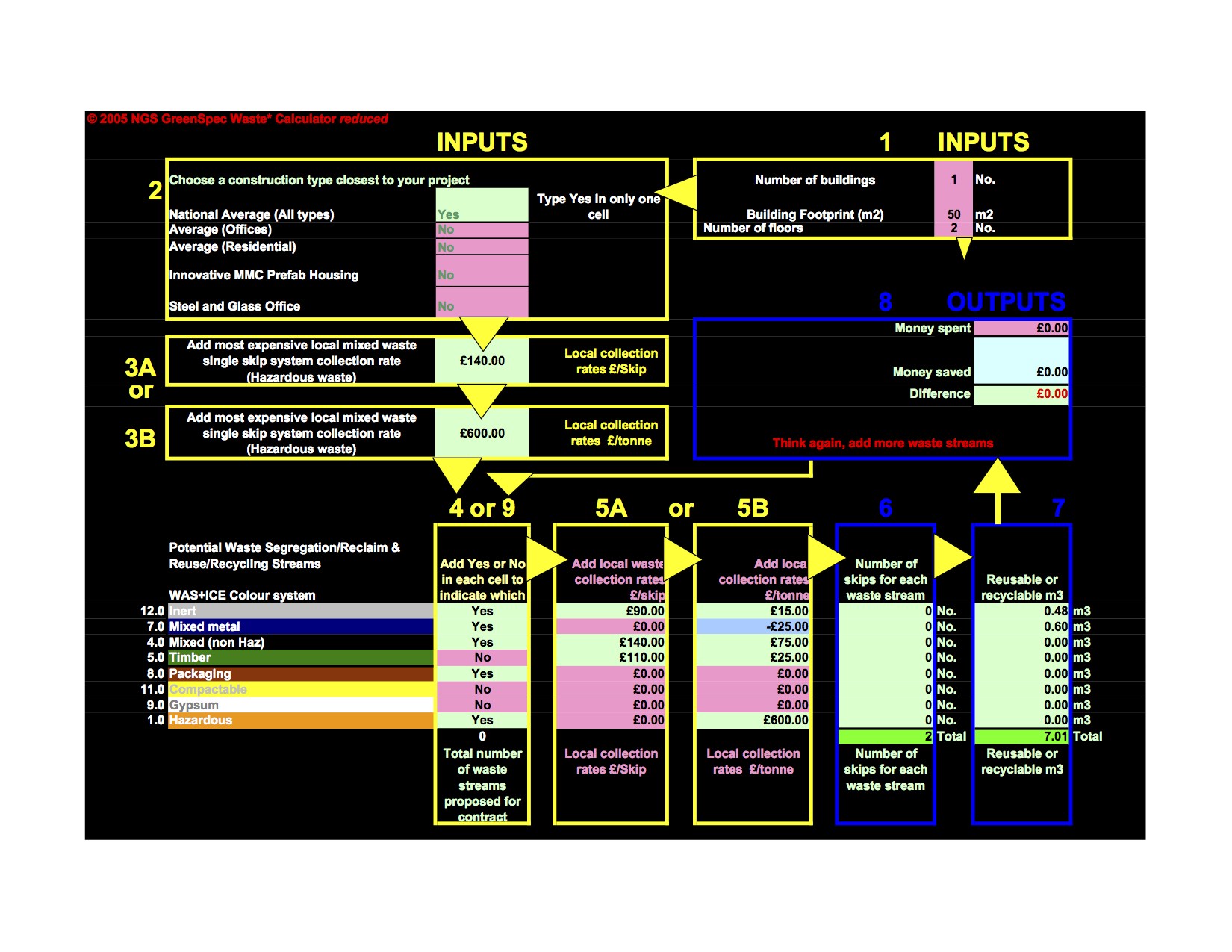
WasteCost®Lite
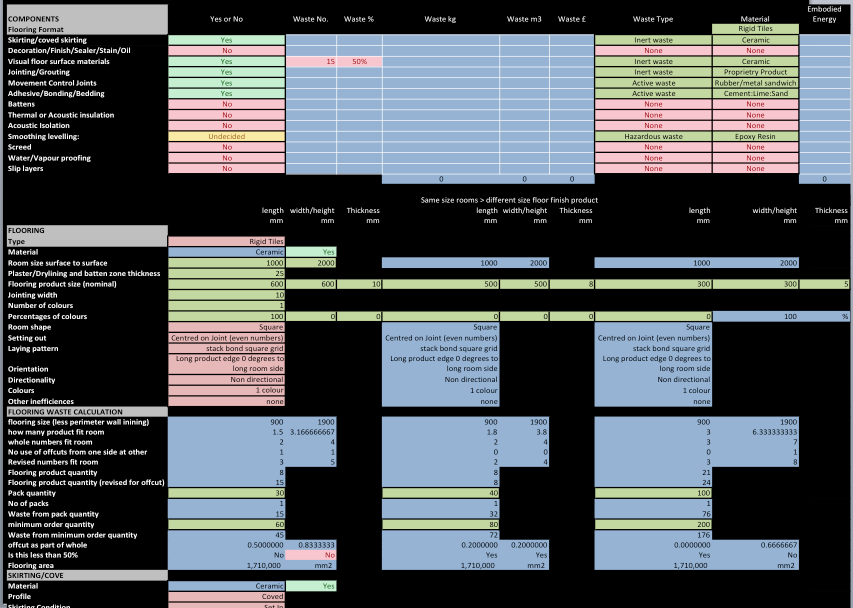
WasteCost®Flooring
NGS CPD
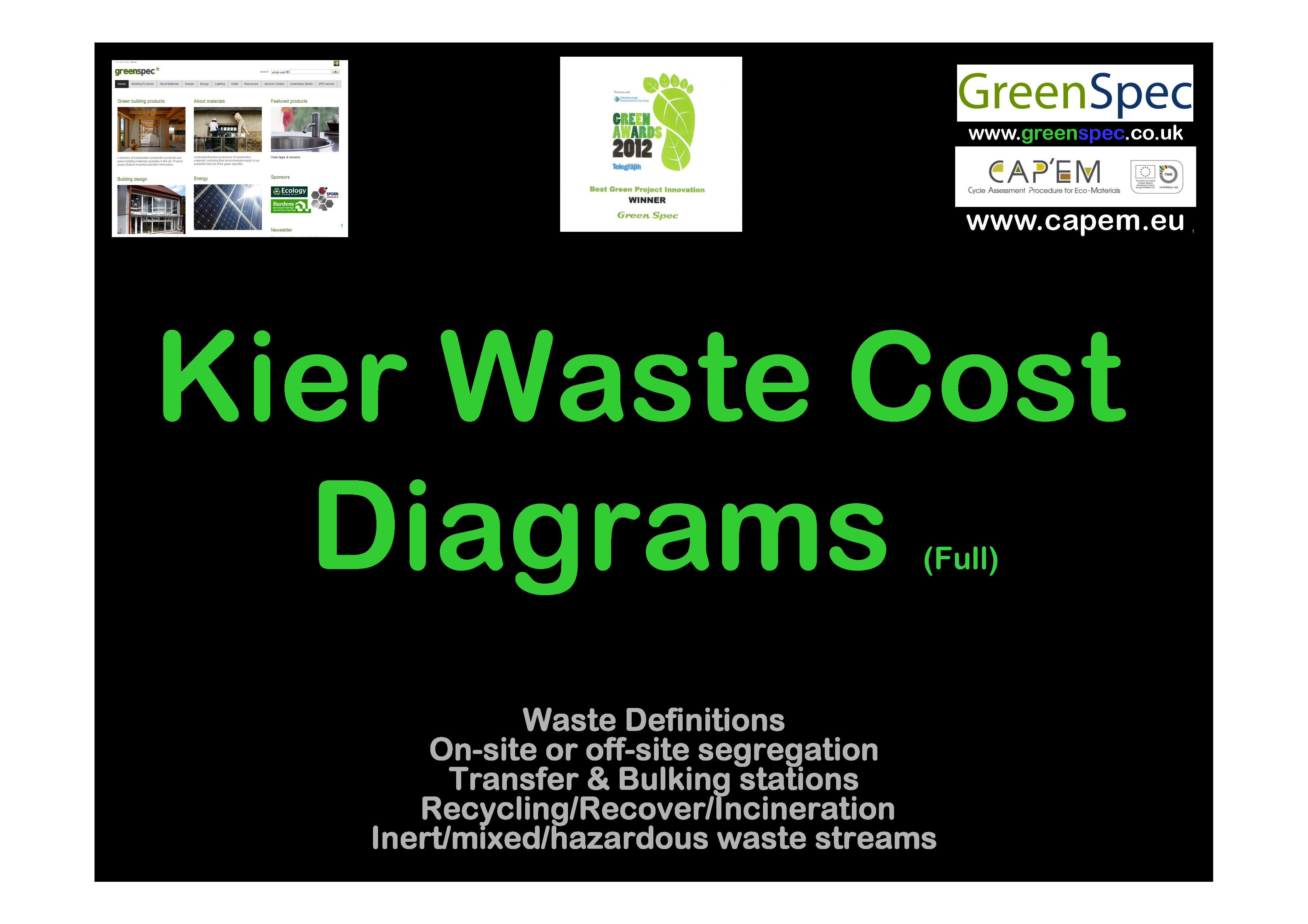
Supply Chain Event

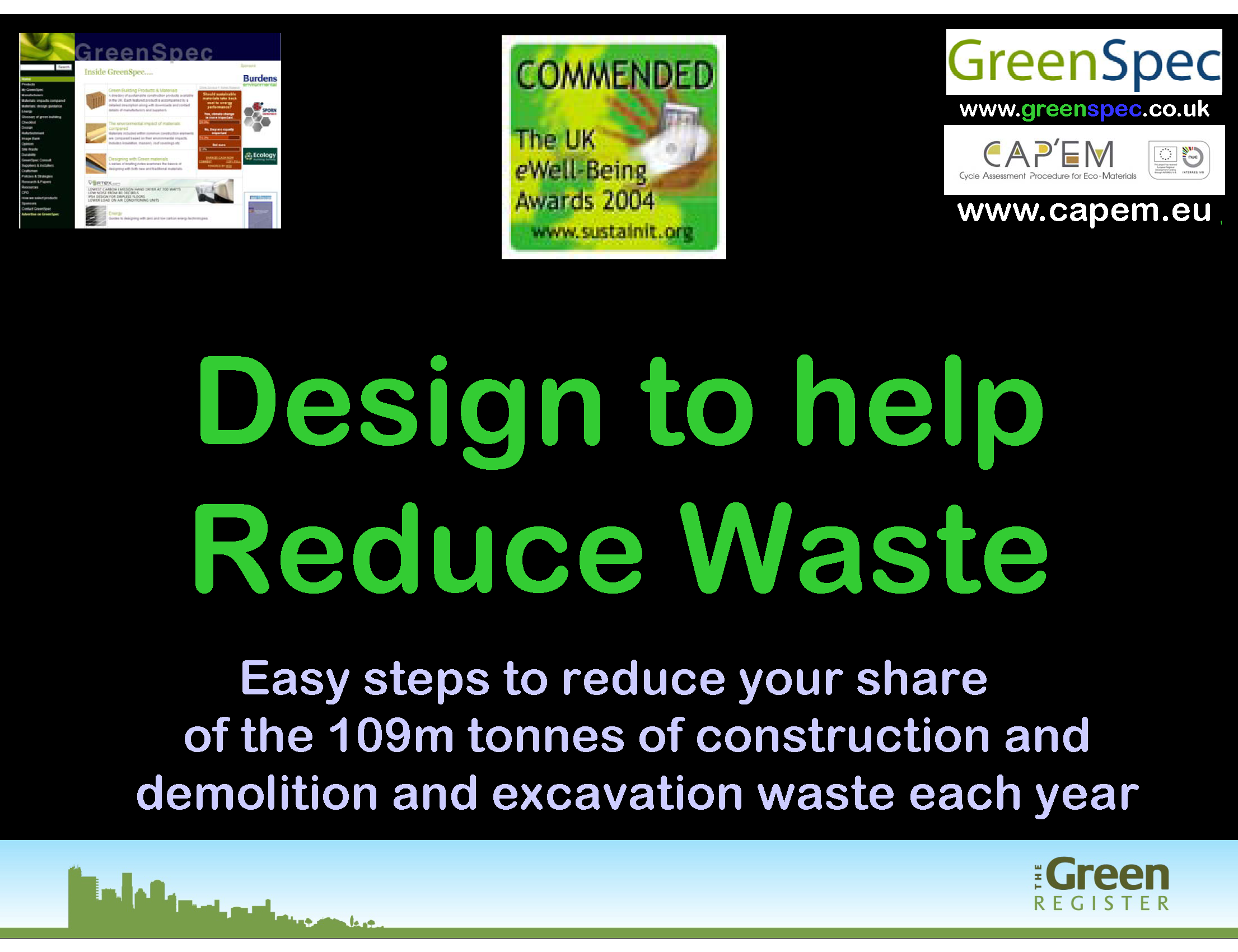
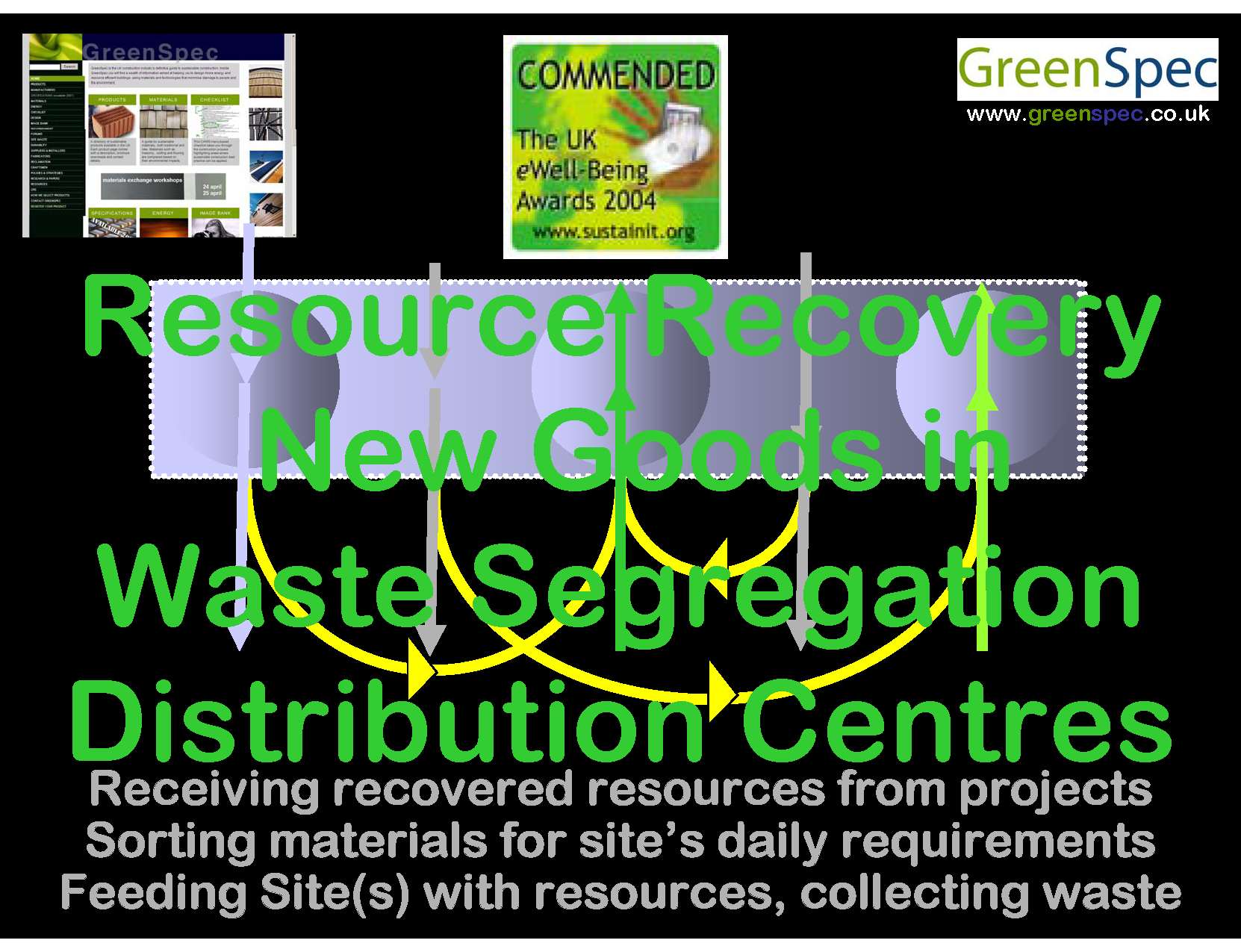
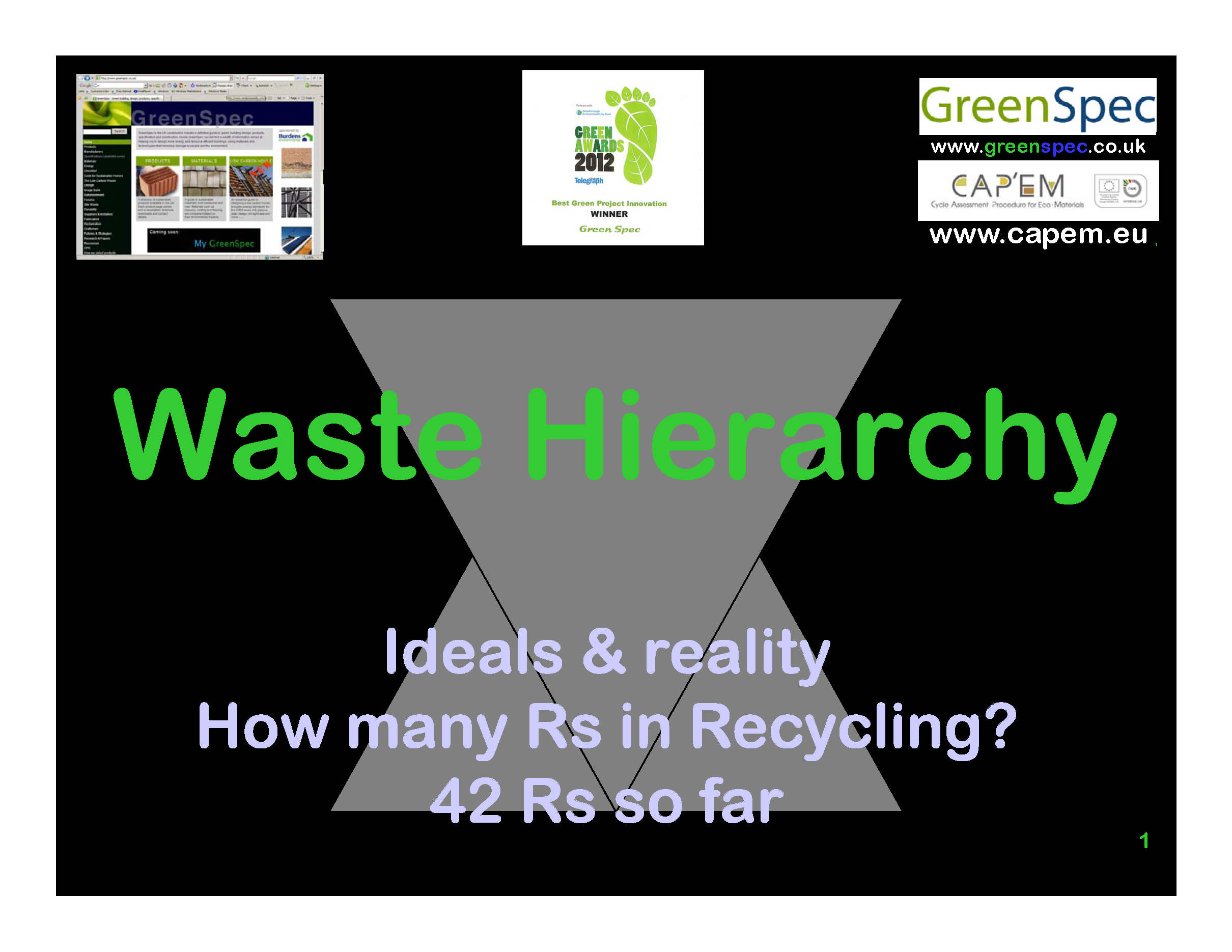
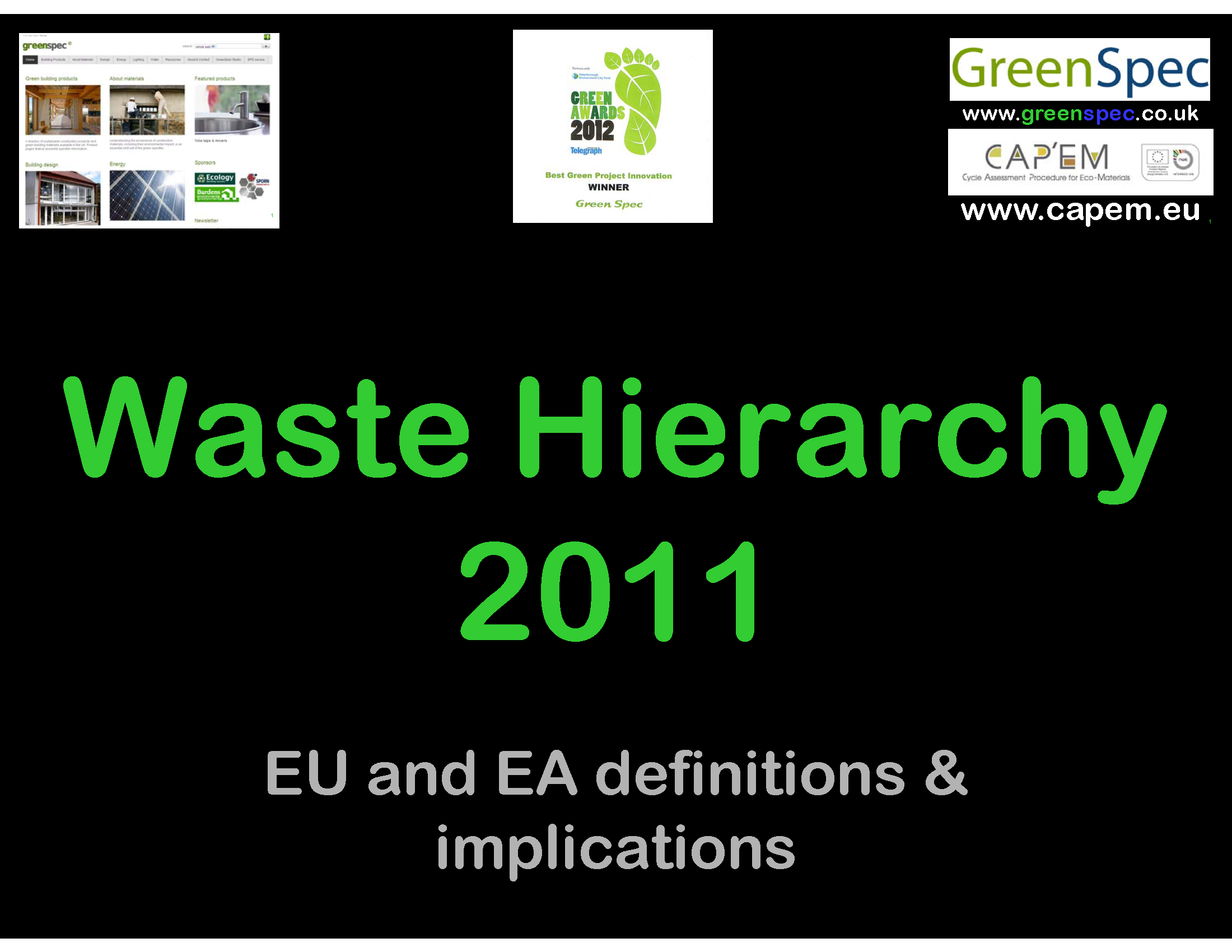
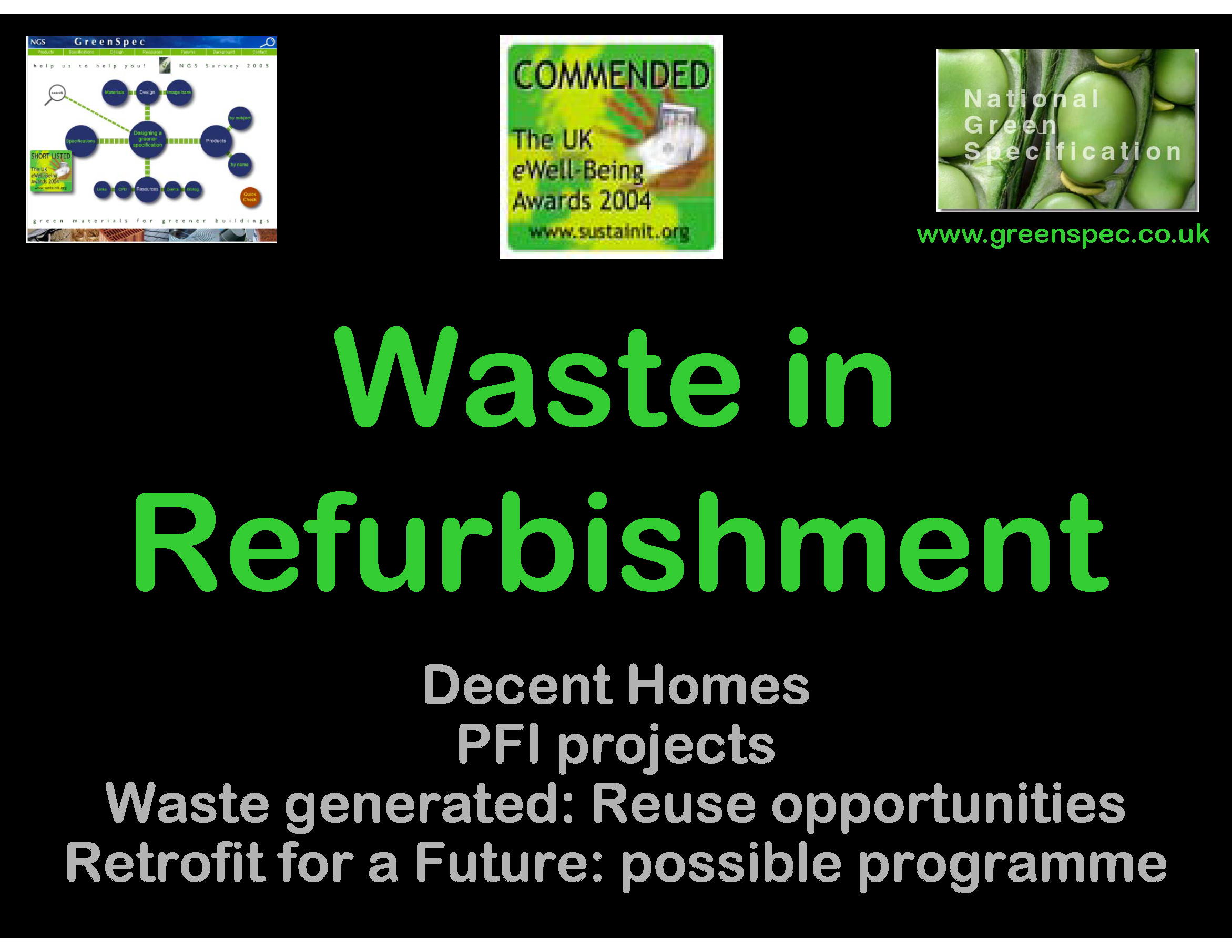
© GBE NGS ASWS BrianMurphy aka BrianSpecMan
12th July 2014 – 22nd November 2018
Waste of Resources
See Also:
NGS JARGON BUSTER
- EWC
- NISP
- PRN
- REAP
- SNRHW
- SWMP
- WEEE
- WTN
- WRAP
- European Waste Catalogue (EWC)
- Hazardous Waste
- Inert Waste
- Inactive Waste
- Mixed waste
- National Industry Symbiosis Programme (NISP)
- Packaging Return Notes (PRN)
- Recovery
- Recycling
- Reduce
- Reuse
- Resource
- Resource Efficiency Action Plan (REAP)
- Segregation
- Site Waste Management Plan (SWMP)
- Stable Non-Reactive Hazardous Waste (SNRHW)
- Voluntary Code Of Practice
- 1286: Waste
- 1287: Waste Broker
- Waste Calculator
- 1290: Waste Champion
- 1289: WasteCost®lite
- 1288: Waste Hierarchy
- 1219: Waste to Energy
- 1269: Waste Stream
- Waste Transfer Notes (WTN)
- Waste Transfer Stations
- 1292: Waste Types
- 1293: WEEE Waste
- 1060: Waste & Resource Action Programme (WRAP)
NGS CPD
Topics
Seminars
- Material Exchange 4 Specification (P)
- Waste Colour Code (P)
- Waste Containers (P)
- Waste Cost Reduction (P)
- Waste Distribution Centre (P)
- Waste Design to Reduce Diagrams (P)
- Waste Hierarchy (P)
- Waste Hierarchy 2012 (P)
- Waste Images Skips (P)
- Waste Refurb Hierarchy (P)
NGS PROJECTS
- 572: DTI Partners In Innovation Waste & Recycling
- 1268: Resource Efficiency Flooring Skills Project
- 565: Building with Reclaimed Components and Materials, A Design Handbook for Reuse and Recycling
- 567: Envirowise Packaging Waste Guide
- 570: WRAP Demolition Module and ICE Demolition Protocol
- 551: WasteCost Lite
NGS CALCULATORS
NGS SOLUTIONS
- _
NGS SYSTEMS
NGS MANUFACTURERS
NGS PRODUCTS
NGS ACCESSORIES
NGS ROBUST SPECIFICATION
© GBE NGS ASWS BrianMurphy aka BrianSpecMan
12th July 2014 – 22nd November 2018

